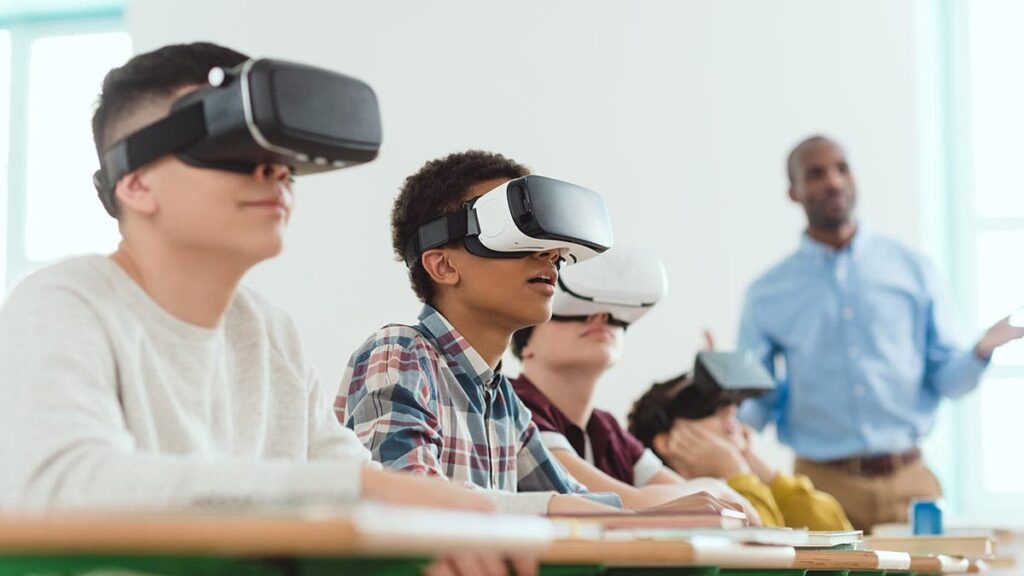
What if you could walk on Mars, explore ancient Rome, or attend a live concert — all from your bedroom?
Welcome to the immersive world of Virtual Reality (VR). No longer confined to gaming alone, VR is transforming how we learn, heal, build, and connect in 2025. As headsets become sleeker, content becomes richer, and 5G unlocks real-time experiences, VR is no longer science fiction — it’s a fast-unfolding reality.
What Exactly Is Virtual Reality?
Virtual Reality is a fully computer-generated environment that immerses users in a simulated world. With the help of a VR headset, motion sensors, and hand controllers, users can look around, move through, and even interact with digital spaces as if they were physically present.
This is different from Augmented Reality (AR), which adds digital overlays onto the real world. VR, in contrast, completely replaces your surroundings with an alternate environment — one that can be realistic, fantastical, educational, or entertaining.
Popular VR platforms and hardware in 2025 include the Meta Quest 3, PlayStation VR2, HTC Vive, and apps like VR Chat and Beat Saber.
How Does VR Work?
At the heart of VR lies the ability to trick your brain into believing you’re somewhere else. This is achieved through:
- VR headsets that provide stereoscopic 3D visuals.
- Motion tracking sensors that capture head and body movement.
- Controllers that let you interact with virtual objects.
- A computer or console that processes the environment in real time.
Some advanced systems even feature haptic feedback, allowing users to feel virtual interactions — adding a tactile dimension to an already immersive experience.
Where VR Is Being Used Today
Though once dominated by gamers, VR in 2025 is making a serious impact across industries:
1. Education & Training
Virtual labs, historical recreations, and simulated environments help students learn complex subjects more intuitively. Corporations use VR for high-risk training scenarios, such as aviation, surgery, and military operations — all in a zero-risk environment.
2. Healthcare
VR therapy is now widely used to treat PTSD, phobias, and anxiety disorders. Doctors also use VR to simulate surgeries, while patients benefit from distraction-based pain relief during procedures.
3. Real Estate & Architecture
Instead of relying on blueprints and renderings, clients can now tour properties and explore 3D models of architectural designs — without being on-site.
4. Entertainment & Gaming
From immersive story-driven games to VR concerts, live sports, and interactive films, entertainment is becoming more sensory, social, and borderless than ever.
5. Remote Work & Collaboration
In a world reshaped by hybrid work, companies are adopting virtual offices, 3D meeting rooms, and collaborative design tools to bring distributed teams together — as if they were sharing the same physical space.
Why VR Matters
The promise of Virtual Reality lies in its ability to make experiences more immersive, accessible, and impactful. Here’s why it’s being adopted at scale:
- Immersive learning makes complex concepts easier to grasp.
- Remote access enables global reach, from virtual tourism to remote labs.
- Safer training scenarios reduce real-world risk.
- Enhanced engagement keeps users focused and emotionally involved.
- Creative storytelling opens new frontiers for art, media, and design.
Challenges Holding VR Back
Despite its promise, VR faces several challenges:
- High costs of headsets and processing devices can limit access.
- Some users experience motion sickness or visual fatigue.
- Content availability is growing but still niche outside gaming.
- Accessibility issues remain for users who lack space or mobility.
That said, each of these issues is being actively addressed through innovation, funding, and growing interest from both creators and consumers.
The Future of VR: What’s Next?
The next frontier of VR is being driven by AI, 5G, cloud computing, and the emergence of the metaverse — a shared virtual world where users live, work, and interact.
What to expect in the coming years:
- Lighter, wireless headsets for better mobility
- Hyper-realistic environments with improved visual fidelity
- AI-powered interactivity that adapts to the user
- Therapeutic and educational integrations in mainstream settings
- Mixed Reality (MR) that blends VR and AR for seamless digital/physical experiences
Big tech players like Meta, Apple, Sony, and Microsoft are already racing to build these ecosystems — and they’re betting big on VR.
Conclusion
Virtual Reality is no longer a niche experiment — it’s a gateway to how we’ll experience the world next. Whether you’re a student stepping inside a virtual classroom, a designer crafting immersive worlds, or a professional collaborating with a remote team, VR is creating new dimensions of possibility.
If you haven’t explored Virtual Reality yet, now’s the perfect time. The gear is better. The content is richer. And the opportunities? Just beginning.





